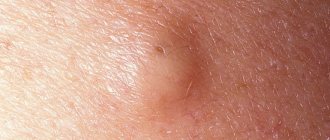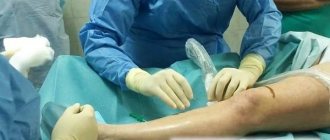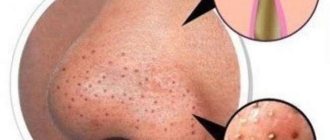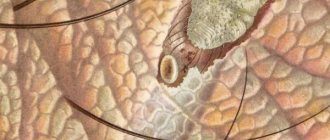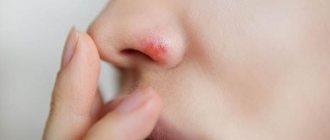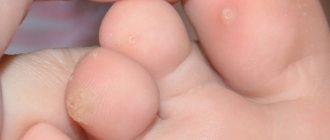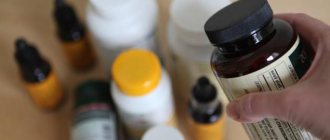What does a scabies mite look like?
The parasite has a flattened light body, the size of which does not exceed 0.1-0.4 mm. Moreover, females are always larger than males. There are suckers on the tick's legs; the parasites lack visual organs. The eggs are oval, their length is about 0.1 mm.
The parasite digs subcutaneous passages that look like dirty brown stripes. They are clearly visible under a microscope.
Mating of a male and female occurs at night. At the end of the fertilization process, the male individual dies, and the female penetrates into the subcutaneous layers, where she lays eggs. On average, 4 larvae emerge every night. The parasite's saliva has the unique property of dissolving the keratin layer of the skin, and the resulting substance serves as food for the tick.
21 days after oviposition, larvae are born and immediately begin to parasitize. Newborn males dig only small branches, while young females build a multi-path network. Full maturation of the itch occurs at the age of 13-14 days. During this period, repeated molting of larvae is observed, which gradually increase in size. Having reached sexual maturity, the parasites come out.
Signs of scabies in humans
- Small blisters appear between the fingers or in the groin (depending on how the infection occurred).
- The blisters burst, leaving inflamed pimples.
- If you look closely, you can see that the “pimples” are arranged in twos: this is the entrance and exit of their subcutaneous mite burrow.
- In the evening and at night the patient begins to feel itching. He literally can't sleep scratching his skin.
- The affected areas become covered with crusts and wounds.
- A secondary infection occurs and small pustules appear.
Symptoms important for diagnosis
The symptoms of scabies determine medical and home treatment. Domestic doctors identify the following signs:
- Ardi's symptom. Rashes, pustules on the elbows.
- Gorchakov's symptom. Scabs (bloody crusts) are also on the elbows.
- Sezari's sign. Slightly protruding scabies and rashes are detected by palpating the affected areas.
- Michaelis symptom. Scabs, bloody crusts in the fold between the buttocks, on the sacrum.
Other complications
Incorrect diagnosis and untimely treatment lead to complications:
- erysipelas;
- septicemia;
- impetigo;
- pyogenic pneumonia;
- felon;
- orchiepididymitis;
- regional lymphadenitis;
- internal abscesses.
Atypical forms
Treatment for scabies at home depends on the stage and form of the disease. Medicine knows of atypical forms in which diagnosis or treatment is difficult.
Scabies without burrows (pseudosarcoptosis) occurs when the itching migrates to the host’s skin from an animal. The parasite, which is not typical for humans, does not reproduce and is not transmitted to other people. As a rule, the tick disappears naturally, without treatment. Scabies incognito. The lot of adherents of hygiene. Symptoms are blurred, diagnosis is difficult. The doctor requires additional research (usually scraping). Infant scabies
Not all doctors distinguish it as a separate type, but it is still advisable to pay special attention to such a lesion. Small children are covered with an itchy rash all over, even the face and skin under the hair. There are frequent errors in diagnosis: scabies in infants is confused with urticaria, dermatitis
Nodular. Increased allergic reaction to tick waste products. Inflamed nodules remain on the body even after the itch itself is destroyed. The nodular rash affects areas with delicate skin: the scrotum, penis, elbows, armpits, buttocks, and around the anus. Crustose (Norwegian) scabies is typical for disadvantaged or very weakened people. Lack of hygiene, low immunity, and inaccessibility to medical care lead to the parasite infecting large areas of the body. There is no itching. The patient is highly contagious. Treating Norwegian scabies at home is highly undesirable.
Errors in diagnosis are common: infant scabies is confused with urticaria or dermatitis. Nodular. Increased allergic reaction to tick waste products. Inflamed nodules remain on the body even after the itch itself is destroyed. The nodular rash affects areas with delicate skin: the scrotum, penis, elbows, armpits, buttocks, and around the anus. Crustose (Norwegian) scabies is typical for disadvantaged or very weakened people. Lack of hygiene, low immunity, and inaccessibility to medical care lead to the parasite infecting large areas of the body. There is no itching. The patient is highly contagious. Treating Norwegian scabies at home is highly undesirable.
Scabies infection
Outside the body of its owner, a tick can live about 3-14 days. The lifespan of the parasite is determined by climatic conditions. It feels most comfortable with high air humidity. The tick lives on the host's body for about 30 days.
There are the following ways of contracting scabies:
- infected environment;
- direct contact with a sick person or his things.
In water, the activity of the parasite increases sharply, so it is easiest to become infected with scabies when swimming in a stagnant body of water. Infection can occur from a larva of any age, however, most often the development of the disease is provoked by a fertilized female. In 24 hours, one female individual is capable of digging a subcutaneous tunnel about three mm long.
Features of scabies infection are determined by the life cycle of the parasite:
- It takes no more than half an hour for itching to penetrate a person’s skin;
- mating occurs in the evening and at night, after which the tick begins to dig tunnels;
- The activity of the parasite ceases with the onset of daylight.
The incubation period after a bite lasts about two weeks, so it is almost impossible to determine exactly how and when the infection occurred.
Itch parasitizes on human skin, clothing, personal items, towels, and bed linen, which also contributes to the rapid spread of scabies.
Treatment of scabies with folk remedies
In addition to traditional prescriptions for scabiosis, which are used by dermatologists, traditional methods of treating scabies, proven over the years, have proven to be excellent. These are effective ways to get rid of scabies mites that do not cause adverse reactions.
Decoctions for the treatment of scabies
Horse sorrel decoction
Prepare a decoction of horse sorrel, let it brew, strain. Wipe itchy and damaged areas of the skin: the itching will subside and the wounds will begin to heal.
Verbena decoction
Prepare a decoction: pour 30 g of verbena into 1 liter of hot water, leave for 3 hours, then strain. Add to water while taking a warm bath, water temperature +35 degrees. The procedure lasts a quarter of an hour, it is advisable to carry it out before going to bed.
Alcohol tinctures for the treatment of scabies
Tincture of fume herb
You need to combine 25 g of dried and ground fume grass with half a glass of vodka and leave for 7 days in a dark place. If immediate treatment is required, and there is no time to wait for this medicine to infuse, you can use freshly squeezed smoke juice to treat the skin.
External remedies for scabies
Elecampane ointment
To prepare the ointment, you need to heat 4 tbsp. l pork fat, add elecampane root, after crushing it, stir, boil for 15 minutes, strain while hot, let cool slightly. Add birch tar (2 tbsp) and sulfur (2 tbsp). Apply ointment to the infected areas several times a day. Leave for 2 hours, rinse with a strong infusion of elecampane root.
Birch tar
Birch tar without impurities is used as a remedy for scabiosis. You should apply tar to the affected areas, after 1-2 hours, wash the affected areas with warm water (you can add a little bran to the water).
Birch tar ointment with soap
You need 2 tsp. combine birch tar with grated laundry soap and melted lard (1 tbsp each), as well as 2 tsp. sulfur. You should get a homogeneous mass. Apply the resulting ointment to the affected areas. After a week, the rash should disappear.
Garlic and onion soap
Soap (laundry) Grate 1 bar on a fine grater, mix with a small amount of water, put on low heat, when the mass begins to stretch, add a head of garlic, chopped on a grater, as well as medium-sized grated onion. The mass will become warm - form it into a convenient bar of soap. They should only wash themselves.
Tomato rub
This recipe is passed down from grandmothers from generation to generation. Heat 0.5 liters of sunflower oil in a frying pan, add chopped tomatoes (1 kg), simmer for 20 minutes, strain when cool. Rub the infected areas on the body 3 times a day. In a week you will forget what scabies is.
Lavender oil
You should rub itchy areas and reddened areas of the skin with lavender oil. To achieve the expected effect, procedures are carried out for several days in a row.
Bay leaf for scabies
Grind bay leaves and mix with butter (1:1). Rub the resulting ointment into the areas affected by scabies.
Celandine for the treatment of scabies
Mix fresh celandine juice with Vaseline (1:4). Lubricate the affected areas of the skin.
Fumigata ointment
Ointment with smoke juice: combine fresh juice with pork fat or Vaseline (1:3). Mix until a homogeneous mixture is formed. Lubricate the diseased skin.
Signs of a scabies mite
Symptoms in humans are determined by the body's reaction to the penetration of the parasite. In this case, the immune system reacts not to the tick itself, but to its metabolic products. Skin itching appears, causing a person to constantly itch, damaging the skin. Pathogenic microorganisms penetrate into the resulting wounds, which further aggravates the situation. Ulcers and ulcers appear on the skin. If you do not seek help in time, the activity of the itch takes on enormous proportions.
The main signs of scabies mites in humans are the following:
- First, small transparent formations appear on the back of the hand or between the fingers, reminiscent of an ordinary allergic reaction. In the late afternoon, as well as at night, the itching intensifies.
- The resulting bubbles begin to burst when combed, leaving behind wounds, ulcers and crusts.
- After some time, you can notice changes in the color of the skin in the affected areas - it becomes grayish. Under a microscope, the passages made by the parasite are clearly visible. Scabies spreads quite quickly throughout the body and after a few days affects almost the entire surface of the skin: buttocks, thighs, abdomen, genitals, chest, back, neck. The favorite habitats of itching are the perineum and armpits.
- Large inflamed bumps form on the body, enlarged lymph nodes, increased temperature, and a feverish state are observed.
Experts distinguish several types of scabies - Norwegian, crusted, nodular. They all have similar symptoms.
Kinds
There are several types of atypical scabies. Briefly about each of them.
Scabies of clean people
Clean scabies , often called incognito scabies, occurs in people who are obsessed with body cleanliness and wash themselves using washcloths several times a day. Or those whose work involves the need to shower before and after work. When a person cleanses his skin, he literally removes the mites that are on the surface, thereby preventing their spread. But intradermal infection still remains.
Norwegian scabies
Norwegian scabies . Norwegian scabies was identified as a separate species in the mid-eighteenth century by doctors from Norway. Unlike ordinary scabies, itching, as a symptom, is present in only half of the patients. The pathogen of this variety settles mainly on the face, neck, scalp and under the fingernails. Also a favorite area of Norwegian scabies is the buttocks. The disease is very contagious, since the number of scabies mites on the body can reach a million! For comparison: in the usual form, their number fluctuates around fifteen pieces.
Pseudosarcoptosis
Pseudosarcoptosis . Sometimes scabies can be contracted from animals by petting street cats or dogs. Pseudosarcoptosis is not so terrible; animal scabies mites are different from human scabies mites and are not able to reproduce in an unusual habitat. They do not form passages on the body and die very soon. Infection of humans with this type of scabies is impossible.
Diagnosis of pathology
A qualified specialist is able to make a diagnosis only on the basis of clinical manifestations. But in some cases, laboratory tests are required to confirm it.
Scabies is diagnosed based on the following data:
- information received from the patient, as well as information revealed during the initial examination - a specific rash on certain areas of the skin, the intensity and frequency of itching in the evening and at night;
- laboratory test results - the parasite and its eggs are detected in scrapings;
- epidemiological data - the patient’s stay in an epidemiological outbreak, contact with possible carriers of scabies and their examination.
As a rule, diagnosing pathology does not cause any particular difficulties. The patient complains of severe itching, which intensifies in the evening and at night, while during the day it practically does not bother him. The specialist also pays attention to the nature of the rash. In advanced cases, the passages of the parasite are clearly visible when examined under a microscope. Under a magnifying glass, you can also see the itches themselves: at the end of the scabies tunnel, transparent or cloudy seals are clearly visible - this is the parasite.
Epidemiological data also play an important role in determining scabies. If one of your relatives has already had this disease, the likelihood of the patient developing an infection increases many times over. It is also possible that you become infected with scabies mites during sexual intercourse if it occurs at night.
The laboratory uses several methods to detect itching in the layers of the epidermis. Mineral oil is used to extract the parasite. A small amount of the product is applied to the exit hole of the scabies tunnel, after which the material along with the parasite is removed out and placed under a microscope. In some cases, it is necessary to give the parasite more physical activity. To do this, heated glass is used; the material for research is taken from papules and vesicles, inside of which there are not only adult individuals, but also their larvae.
An additional diagnostic method is the examination of subungual contents, in which larvae or traces of the vital activity of itching can also be detected.
If scabies are not visible on the surface of the skin, the specialist decides to conduct an ink test. Blue ink is applied to the affected area, after which the excess is removed using alcohol. The paths that remain colored are the scabies tunnels, from which scrapings are taken for analysis. Instead of ink, aniline dyes, ink or iodine can be used.
Also quite effective is the rapid diagnostic method, which is carried out using a solution of lactic acid (40%).
The diagnosis is considered confirmed if the test material contains scabies parasites, their eggs and larvae, as well as empty shells from underneath them. In complex cases, the disease is diagnosed by obtaining a positive effect after a course of anti-scabies therapy. So, if the first treatment with special preparations led to positive results - the itching disappeared, a gradual decrease in the rash was observed, etc., it means that there is itching in the patient’s body.
Complications
Complications
Scabies, like any other disease, if left to chance, will inevitably lead to complications.
When scratching, open wounds are formed, into which infection enters from the outside and a purulent lesion begins. Abscesses, boils, allergic dermatitis and microbial eczema, erysipelas are not excluded. And in especially severe cases, the heart muscle and kidneys are affected.
Therefore, do not hope that “the pain will hurt and stop”; it is necessary to treat scabies! Especially if a child gets sick, there are known cases of death of young children from complications after the disease.
Treatment methods
The main goal of treating scabies mites in humans is to eliminate them. This is achieved with the help of special acaricidal agents. As a rule, therapy is carried out on an outpatient basis. But in especially severe cases, hospitalization is prescribed. This may be the case when:
- the patient is not able to independently perform the prescribed procedures due to existing mental illnesses, neurological pathologies, etc.;
- Norwegian type of scabies was diagnosed;
- inability to isolate the patient from organized groups - hostels, orphanages, etc.;
- there are complications in the form of pustular lesions with the appearance of multiple purulent formations (ecthyma, boils), elevated temperature, and enlarged lymph nodes.
Persons infected with scabies who live in the same area should be treated at the same time.
Therapeutic measures are carried out before bedtime, since it is at this time that the parasite becomes active, which significantly increases the likelihood of acaricidal agents getting into its food. In addition, it is necessary to carry out preventive measures in relation to the following categories of the population:
- sexual partners located outside the outbreak area;
- persons who are forced to be close to a sick person for some reason, including those living in the same area with him.
For adults, anti-scabies are applied to the entire surface of the body, except for the scalp and face. For children under three years of age, the head is also treated. Rub the medicine with your hands, which promotes the greatest penetration of the product into the tick passages on the hands. The medicine must be present on the surface of the skin for at least 12 hours.
Before the start of the course of treatment, as well as after its completion, a mandatory change of bed linen, clothing, and body washing is carried out. Hands are lubricated with medicinal ointment after each rinsing. Disinfection of things and household items is also a prerequisite. Clothes and bedding can be folded into a bag, tied and placed in the open air, left for a week. Boiling will also help kill scabies mites. It is necessary to boil things for 10 minutes in a solution of soda or washing powder.
Prevention
Prevention
It has already been said that family members must undergo at least one skin treatment. All bedding, linen and clothing must be washed at the highest water temperature. There is no need to worry about upholstered furniture, since it has been proven that the scabies mite in the external environment is not able to survive and dies within 24 hours. Moreover, its activity disappears almost immediately. An interesting experiment proving this fact was carried out in Great Britain in the forties of the last century. First, a person with scabies was put into bed, and then a healthy volunteer of the experiment went into the same bed. Of the two hundred and seventy-two people, only four became infected. The conclusion follows: it is possible to become infected through household items and bedding, but this happens extremely rarely. Another thing is with body-body contact – infection is almost inevitable.
Medications
Scabicides (acaricides) are available in the form of creams, ointments, emulsions, lotions and aerosols. Three main groups of such drugs are used in the treatment of scabies. These are the following categories of drugs:
- preparations based on pyrethroids - synergist piperonyl butoxide, esdepalletrin, permethrin, etc.;
- products containing benzyl benzoate;
- Sulfuric ointment.
Most often, the doctor prescribes the following medications:
- Benzyl benzoate. The drug is based on benzyl ether. The product is intended to kill only males and females. The eggs of the parasites do not die. Release forms: emulsion and ointment.
- Medifox. The drug contains permethrin. Used to kill both adults and larvae. Produced in the form of a concentrated emulsion. Medifox is contraindicated for persons with liver and kidney failure, small children (under 12 months), and nursing mothers. During pregnancy, the product must be used with extreme caution.
- Sulfuric ointment. The product has shown high efficiency in the fight against larvae and adult parasites, but sulfur ointment has no effect on eggs. Contraindications: pregnancy and lactation.
Benzyl benzoate
Medifox
Sulfuric ointment
In addition to the above remedies, the following drugs are widely used:
- Spregal;
- Eurax;
- Lindan;
- Wilkinson's ointment, etc.
Wilkinson's ointment
Spregal
Lindan
Eurax
Recipes from Vanga
Vinegar rubdowns
- Vanga recommended that at the first signs of scabies, generously moisten the skin with table or apple cider vinegar, apply a bandage made of the coarsest natural fabric and leave for two hours. Repeat the procedure twice a day.
- Prepare an ointment from a spoonful of birch tar, melted lard, green soap and a spoonful of white chalk powder. Mix the ingredients until completely combined and rub the ointment into the areas affected by the tick twice a day. At the same time, you cannot wash or even just wet the skin! And only after five days of continuous treatment can you wash, preferably in a bathhouse.
Traditional methods
You can also get rid of itching at home. Traditional medicine offers many recipes for the preparation of medicinal products, which are based on essential oils, wood ash, kerosene and other ingredients. Here are some of them:
- Oil, kerosene, fuel oil, gasoline. Take any of the listed substances, dilute with vegetable oil in a 1:1 ratio. Lubricate the affected skin before going to bed. The course of treatment is 2-3 days.
- Wood ash. It must be mixed with fat in a ratio of 30/70. Use as a regular anti-scabies ointment.
- Therapeutic baths using essential oils are also effective. It is necessary to carry out 10 procedures over 20 days, that is, a bath is taken once every 2 days.
The incidence of scabies in our time still remains at a high level and no one is immune from this. The disease can be caught anywhere: public transport, a bathhouse, child care facilities, etc. Uncomplicated forms are treated quite easily, but it is still better to prevent infection by following preventive measures. If you suspect the development of scabies, you must immediately contact the clinic and undergo appropriate treatment.
Blitz recipes
- Grind the chalk to a fine powder and dust the sore skin with it, lightly rubbing the chalk.
Lavender oil
- Or just buy lavender oil, which scabies mites really don't like, and rub it on your skin three times a day. You will be guaranteed a pleasant smell from your skin and relief from an unpleasant disease.
